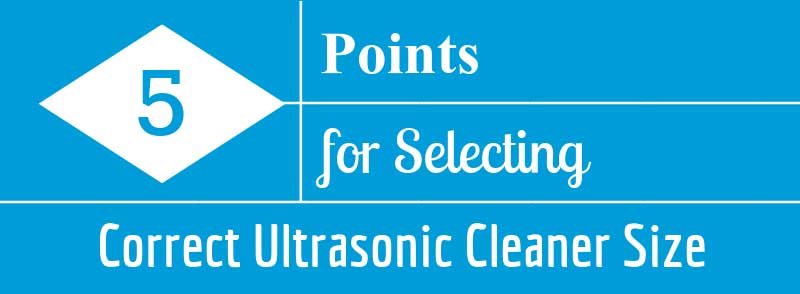Posts Tagged ‘ultrasonic parts cleaner’
Two Practical Solutions to Clean Lab Sieves
Cleaning fine mesh particle analysis lab sieves becomes more difficult as mesh size decreases, making it more likely that particles become trapped in fine sieve openings. Manual cleaning test sieves has drawbacks including potential damage to the mesh and failure to achieve 100% particle removal. Here are two practical solutions to clean lab sieves as well as perform other important functions in food and pharmaceutical research facilities.
Lab Sieve Cleaning Solution No. 1
One way to solve the problem is by combining the 7.5-gallon Elmasonic EP300H ultrasonic cleaner with the Elma SRH 4/200 sieve rotation holder.
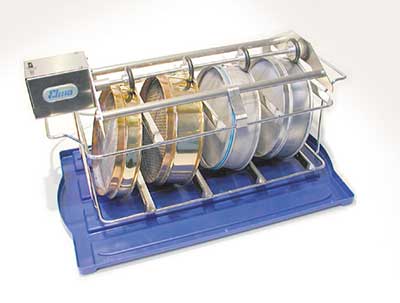
Ultrasonic cavitation produced by the Elmasonic EP300 H creates billions of minute vacuum bubbles. These implode vigorously against the surfaces of objects being cleaned to quickly and safely dislodge contaminants.
The unit operates at 37 kHz ultrasonic frequency. Features include a heater (30⁰ – 80⁰C) and a timer (1 … Read the rest
5 Key Points to Selecting the Correct Ultrasonic Cleaner Size
Ultrasonic parts cleaners are manufactured in a tremendous variety of sizes. By “size” we mean the dimensions and capacities of tanks in which ultrasonic parts cleaning is accomplished. For example the Elmasonic E Plus series is offered in 9 tank capacities from 0.25 to 7.5 gallons and the Select Series in 11 capacities from 0.7 to 23 gallons. Industrial-sized units such as SHIRACLEAN can hold 100 gallons or more. This post will help you select the correct ultrasonic parts cleaner size.
Five Points to Selecting your Ultrasonic Parts Cleaner Size
Here are the key points to consider:
- Parts you are cleaning
- Cleaning tank dimensions
- The importance of “working depth”
- The role of cleaning baskets
- Cleaning solution volume and service volume
1. What Parts are you Cleaning?
Ultrasonic parts cleaning has proved a very effective and economical way to remove all types of contaminants from nearly anything that can be safely … Read the rest
How to Select Ultrasonic Cleaner Accessories
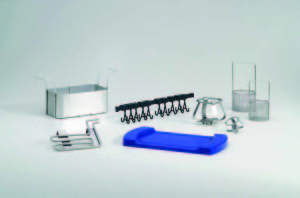
Think of selecting ultrasonic cleaner accessories as though you are buying a new car. You have the choice of standard equipment and equipment or features that are “optional at extra cost.”
The “options” largely depend on the ultrasonic cleaner manufacturer. This is why it is important for you to have a clear understanding of what you want to accomplish in your ultrasonic cleaning process. Our post on ultrasonic cleaner application ideas provides a good tutorial on this.
This post is designed to help you select ultrasonic cleaning accessories that are either required to help you quickly and successfully accomplish your ultrasonic cleaning tasks or simply “nice to have.”
Similarly this post does not go into detail on selecting a specific ultrasonic cleaner. That is generally based on the size of your operations and what you intend to do with the equipment. We cover this topic in … Read the rest
Ultrasonic Cavitation vs. Air in an Ultrasonic Cleaner
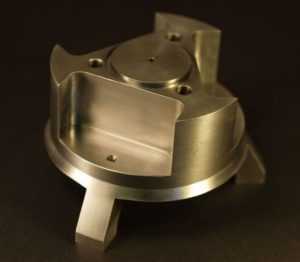
Ultrasonic cleaning procedures described in our posts nearly always call attention to the importance of degassing fresh cleaning solutions. Degassing is the process of removing trapped air in liquids. You can see this by letting a glass of water stand for awhile and note the bubbles that appear on the inside surface. Trapped, entrained or dissolved, air inhibits cavitation, which is the implosion of micron-size vacuum bubbles that accomplish the cleaning.
Simply operating the equipment for a time, the length of which depends on the volume of cleaning solution, will drive off trapped air. The process can be hastened by a Degas mode on an ultrasonic cleaner. It does the job by switching on and off causing air bubbles to coalesce and allowing them rise to the surface and burst.
Removing Other Air in an Ultrasonic Cleaner
Air can be introduced into … Read the rest
Sonic Cleaning Solves 3D Printing Mold Support Challenge
3D printing, also called fused deposition modeling and fused filament fabrication, has revolutionized and lowered the cost of traditional molding techniques such as the lost wax process. By using two moldable thermoplastic formulations such as ABS for the part itself and PLA for removable mold supports 3-D printing is capable of quickly producing highly complex configurations.
A key to the efficiency of the process is fast, safe removal of the PLA mold support without risking damage to the ABS part. An ultrasonic cleaner is proven far faster, safer and more effective than water sprays or manual scrubbing.
3-D Printing in Brief
Computer aided design files for components are programmed into the 3D printer which uses thermoplastic filaments to create components by successively building up extremely thin layers of plastic. The ABS filament ends up as the product; the PLA filament, deposited at the same time, serves as a support for … Read the rest
How to Position Parts in an Ultrasonic Cleaner
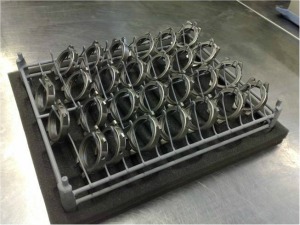
Correct parts positioning in an ultrasonic cleaner is as important as the ultrasonic cleaning frequency and ultrasonic cleaning solution formulation. Yet of these three criteria improper parts positioning is often the cause of unsatisfactory results or extended time in the cleaning solution.
Don’t Fight Cavitation
Better said, don’t impede cavitation action. Cleaning is accomplished by the violent implosion of minute bubbles created in the cleaning solution by ultrasonic transducers. The cleaning action occurs on all surfaces wetted by the solution as sound waves migrate upward through the solution from the bottom of the ultrasonic cleaner tank and reflect back down from the solution surface. This suggests that putting too much product in the cleaning baskets is not a good idea because it will impede sound reflection. At Tovatech we recommend a 1 to 2 inch space between the tank walls and parts in … Read the rest

